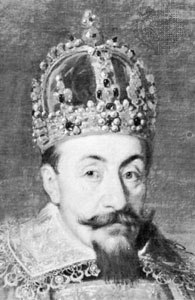Muscovy Crown
Muscovy Crown refers to the crown of the Grand Duchy of Moscow, also known as Muscovy, which was a significant state in medieval Russia. The Muscovy Crown symbolized the authority and sovereignty of the Grand Duke of Moscow. Over time, as the Grand Duchy of Moscow evolved into the Tsardom of Russia, the Muscovy Crown came to represent the broader Russian state's imperial ambitions and authority.
History[edit | edit source]
The origins of the Muscovy Crown can be traced back to the early 14th century when the Grand Duchy of Moscow began to emerge as a powerful regional principality. Under the leadership of princes like Ivan I and Dmitry Donskoy, Moscow expanded its territories through warfare, diplomacy, and the strategic marriage of the Moscow princes. The crown itself, as a physical object, has been lost to history, but its symbolic significance has been well documented in Russian chronicles and the annals of neighboring states.
During the reign of Ivan III, also known as Ivan the Great, the Muscovy Crown became a symbol of the unification of Russian lands. Ivan III's marriage to Sophia Palaiologina, a niece of the last Byzantine Emperor, further enhanced the prestige of the Muscovy Crown, linking Moscow's rulers to the legacy of the Byzantine Empire and positioning them as the inheritors of the Orthodox Christian tradition.
Symbolism[edit | edit source]
The Muscovy Crown was not just a symbol of political authority but also of the divine right of the Moscow princes to rule. It was often depicted in religious and ceremonial contexts, emphasizing the connection between the church and the state in medieval Russia. The crown's design, which may have included elements borrowed from Byzantine and Eastern Orthodox Christian iconography, reinforced the idea of Moscow as the "Third Rome," a concept that became increasingly popular after the fall of Constantinople in 1453.
Legacy[edit | edit source]
With the establishment of the Tsardom of Russia in 1547, when Ivan IV was crowned as the first Tsar of Russia, the Muscovy Crown's significance was absorbed into the new imperial regalia. However, its legacy continued to influence Russian symbols of state and the conceptualization of Russian autocracy. The crown remains a potent symbol in the historical narrative of Russia, representing the medieval origins of the Russian state and its transformation into a major empire.
See Also[edit | edit source]
Search WikiMD
Ad.Tired of being Overweight? Try W8MD's physician weight loss program.
Semaglutide (Ozempic / Wegovy and Tirzepatide (Mounjaro / Zepbound) available.
Advertise on WikiMD
|
WikiMD's Wellness Encyclopedia |
| Let Food Be Thy Medicine Medicine Thy Food - Hippocrates |
Translate this page: - East Asian
中文,
日本,
한국어,
South Asian
हिन्दी,
தமிழ்,
తెలుగు,
Urdu,
ಕನ್ನಡ,
Southeast Asian
Indonesian,
Vietnamese,
Thai,
မြန်မာဘာသာ,
বাংলা
European
español,
Deutsch,
français,
Greek,
português do Brasil,
polski,
română,
русский,
Nederlands,
norsk,
svenska,
suomi,
Italian
Middle Eastern & African
عربى,
Turkish,
Persian,
Hebrew,
Afrikaans,
isiZulu,
Kiswahili,
Other
Bulgarian,
Hungarian,
Czech,
Swedish,
മലയാളം,
मराठी,
ਪੰਜਾਬੀ,
ગુજરાતી,
Portuguese,
Ukrainian
Medical Disclaimer: WikiMD is not a substitute for professional medical advice. The information on WikiMD is provided as an information resource only, may be incorrect, outdated or misleading, and is not to be used or relied on for any diagnostic or treatment purposes. Please consult your health care provider before making any healthcare decisions or for guidance about a specific medical condition. WikiMD expressly disclaims responsibility, and shall have no liability, for any damages, loss, injury, or liability whatsoever suffered as a result of your reliance on the information contained in this site. By visiting this site you agree to the foregoing terms and conditions, which may from time to time be changed or supplemented by WikiMD. If you do not agree to the foregoing terms and conditions, you should not enter or use this site. See full disclaimer.
Credits:Most images are courtesy of Wikimedia commons, and templates Wikipedia, licensed under CC BY SA or similar.
Contributors: Prab R. Tumpati, MD

